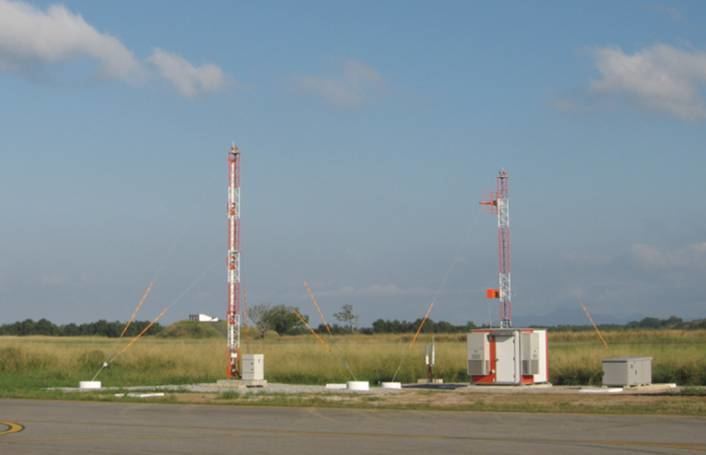 | ||
A transponder landing system (TLS) is an all-weather, precision landing system that uses existing airborne transponder and instrument landing system (ILS) equipment to create a precision approach at a location where an ILS would normally not be available.
Contents
Description
Conventional ILS systems broadcast using a number of "single purpose" antennas. One, located just off the end of the runway, provides a fan-shaped signal for azimuth direction (side to side) and another located beside the runway provides elevation to indicate a standard glideslope. ILS installations also include one or more "marker beacons" located off the end of the runway to provide distance indications as the aircraft approaches the runway. This complex set of antennas is expensive to install and maintain, and are often difficult to site in built-up areas.
How it works
The TLS facility interrogates the transponders of all aircraft within 60 nautical miles (110 km). After receiving a response, TLS determines the aircraft's location using three sets of antenna arrays: one for horizontal position using monopulse techniques, the other for vertical monopulse and a third for trilateration. TLS then calculates the position of all aircraft using the transponder responses. Any aircraft conducting a PAR-type approach can be viewed on the TLS PAR format console displaying azimuth and elevation. Up to five different aircraft may be viewed independently on five different consoles to assist a PAR controller with a conventional PAR talk-down approach. For one aircraft conducting an ILS approach, the TLS produces a signal that the aircraft would "see" if they were located at that location and approaching a conventional ILS system, and then broadcasts that signal to the aircraft. The aircraft's ILS receivers receive a signal that is indistinguishable from a normal ILS signal, and displays this information on standard ILS glideslope and localizer displays. TLS can also produce marker beacon-like audio to indicate distance at appropriate times during the approach. All the pilot has to do is tune in the TLS system as if it were an ILS.
Uses
A TLS can be installed in areas where a conventional ILS would not fit or would not function properly, like, for example, an airport that doesn't have a proper reflecting surface for an ILS glideslope because of uneven terrain like steep hills or mountains, or airports that have large buildings like hangars or parking garages that create disruptive reflections that would prevent an ILS localizer from being used. TLS does not even have to be installed at a particular location relative to the runway, but can "offset" its signals from wherever it is installed to appear as if it were at the end of the runway. This makes it much less expensive to install while still providing ILS-class blind-landing approaches. In 1998, TLS was certified by the FAA for Category I ILS usage.
Radio-navigation aids must keep a certain degree of accuracy (given by international standards such as FAA, ICAO, etc.). To assure this is the case, flight inspection organizations periodically check critical parameters on properly equipped aircraft to calibrate and certify TLS precision.
Benefits
One of the primary benefits of TLS is the ability to provide precision ILS guidance where terrain is sloping or uneven, reflections can create an uneven glide path for ILS causing unwanted needle deflections. Additionally, since the ILS signals are pointed in one direction by the positioning of the arrays, ILS only supports straight-in approaches. TLS supports approach over rough terrain and provides the ability to offset the approach center-line.
With TLS, the localizer course can have a tailored width at the runway threshold (700 feet and 5 degrees typically) regardless of the runway length. The localizer width characteristics can be selected by the approach designer whereas with an ILS the localizer width is determined by the localizer antenna placement which is usually a consequence of runway length.
For military users, TLS also provides a Precision Approach Radar (PAR) graphic display of aircraft position compared to the desired approach course in order for a PAR operator to provide talk-down guidance to the pilot. Since the TLS operates using the long range band of SSR (1030/1090 MHz) there is no rain fade such as experienced with a traditional PAR that uses primary radar. For a traditional PAR, the ability to track the aircraft position is dependent on the aircraft radar cross section.
TLS is based on transponder multilateration and trilateration and consequently tracks all aircraft that respond to the interrogations. Omnidirectional antenna surveillance coverage of the TLS extends to 60 nautical miles.
The TLS functions using airborne equipment that is currently widely used by the aviation industry. TLS uses the existing Mode 3/A/C/S transponder equipment to determine the aircraft's position. It then transmits the correct signal on the same frequencies used for the current ILS system. All the pilot is required to do is wait for clearance from ATC for the TLS approach and then tune an ILS receiver to the appropriate frequency. TLS uses equipment most airplanes already have.
Drawbacks
Since the TLS simulates an ILS signal that is specific to one aircraft's location, only one aircraft at a time may be cleared for the TLS landing approach. Any other aircraft in the area will receive the same guidance regardless of their location relative to the approach and must wait to be cleared by ATC. The transponder code for the cleared aircraft is selected at the remote control unit.
Variations
For mobile applications, primarily of interest to the military, there is a variety of electronics packaging available including transportability by trailer, HMMWV or NATO shelter.
